What animals live in Antarctica? Fun facts about polar wildlife
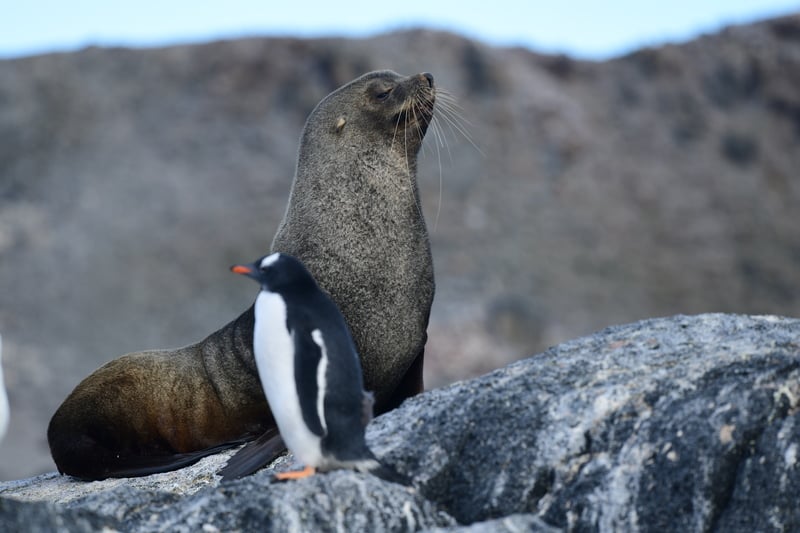
It’s the driest and coldest place on Earth, with harsh weather and winds sweeping through the bleak plains of Antarctica. Not the place where you’d settle down? Surprisingly, for some well-adapted species this is paradise. Did you know that this remote continent abounds with wildlife? More than 200 species call Antarctica their home. Read on and find out who those tough guys are and what makes them so special!
Krill – Superfood of the ocean
From over 86 species of krill worldwide, only five types live in the Southern Ocean. These crustaceans range from less than a centimeter to a maximum of 14 cm in length. While you can usually see them in swarms on the ocean surfaces (down to 250m below), they are avid divers and scientists found them as deep as 2,000m at the seafloor. Whales, seals, penguins and sea birds depend on these little delicacies, which are made up of over 60% protein, Omega-3 fatty acids and amino acids. But they aren’t just important for food. Krill excrements fertilize the ocean, providing nutrients for underwater plants and phytoplankton. Believe it or not, but krill poop is so nutritious that krill even eat each other’s feces! Being such an important part of life in Antarctica, krill are known to be tough little guys. Dieting mostly on phytoplankton, they can survive up to 200 days without food if needed, which comes in handy during those cold winter months in the Southern Ocean. And did you know that they even glow in the dark? Due to a chemical reaction and luminous spots along their sides called photophores, they can produce a blueish light!
Penguins – Torpedoes in tuxedos
As icons of Antarctica, they are the highlight for most expeditioners and photographers visiting the White Continent. You won’t find penguins in natural habitats anywhere else on Earth but the Southern Hemisphere. But penguins are so much more than cute little fellows waddling around the Antarctic shores! Penguins are excellent swimmers and divers. While clumsy on land, they’re real athletes underwater. Their torpedo-shaped bodies reduce drag in the water and their flippers function as propellers during swimming. Gentoo penguins are the fastest of them all, reaching up to 36km/h (22mph)! Emperor penguins have yet another trump card up their sleeves – or should we say bubbles up their feathers? Trapping air under feathers and releasing them underwater as bubbles reduces density of the water surrounding them, reducing drag and boosting their speed. Know your penguins! Discover the eight species of penguins that live in Antarctica and on the subantarctic islands:
%20(1).jpg)
Emperor penguins: As the largest species of them all, Emperor penguins reach up to 122cm (48 inches) in height and weigh up to 45kg (99lbs)! You’ll only find them on the Antarctic continent, usually in large colonies on the sea ice. Harsh winds of up to 200km/h (124 mph) and temperatures of -50C (-58F) don’t bother these fellows or their offspring. Emperor penguin parents breed a single egg each season and, given the bleak conditions on the ice, do not build any nest. Instead, the female passes the egg to the male for incubation, while she heads out to sea to feed. Penguin dad looks after the egg for nine weeks, keeping it warm on his feet by covering it with a skin fold and losing up to 45% of his body weight during that period. Young emperor penguin chicks are quite literally ugly ducklings before they mature. With their fluffy brown adolescent coat, they look nothing like their adult parents who feature the iconic white and black attire with orange-yellow marks around their heads. And did you know that emperor penguins are the deepest divers among their species? They can dive up to 450m (1,476 feet)!
King penguin: Coming second in size after the emperor penguins, kings reach up to 94cm (37 inches). You can spot them on the subantarctic islands such as South Georgia in massive colonies. No nest needed – king penguins lay their egg and carry it on their feet under a skin fold. Similar to emperors’ chicks, they’re covered in brown fluff, which they shed to gain waterproofness to be able to swim in the ocean. They’re laid back and don’t mind travelers, as long as you keep a safe distance away from their colonies. You can see them on our cruises heading to South Georgia Island!
.jpg)
Adélie penguin: Calling Antarctica their home, they spend winters on the pack ice and summers on the coastlines of the Antarctic islands. Adélie penguins breed in large colonies, usually raising two chicks each season. Like many other penguin species, chicks spend their childhood in crèches (nurseries) and are communally cared for until they’re ready to head out to sea, returning only after 3-5 years when they’re ready to breed themselves. At a maximum height of only 71cm (28 inches), these birds are quite feisty! Ever been slapped by a penguin? Better step back! They’re known to take on predators like seabirds, seals and even the occasional scientist isn’t safe from their flappy flippers.
%20(1).jpg)
Chinstrap penguins: As the most abundant penguin species in the world, you can see them in Antarctica and the subantarctic islands. True to their name, you’ll recognize them by the little black band under their beaks, which makes them look like they’re wearing a little helmet. They prefer rocky and ice-free coastal areas for breeding and form large colonies. To feed they swim as far as 80km (50 miles) off the shores daily to feed on fish and krill.
%20(1).jpg)
Gentoo penguin: Spot them in Antarctica and on the subantarctic islands where they build their nests on picturesque beaches! Courtship between Gentoos involve pebbles being gifted by males to their females. If Ms. Gentoo approves of the stone, she’ll place it on the spot where she’ll want the nest to be. Some lazy Gentoo males have been seen stealing stones from others to impress their mates!
.jpg)
Macaroni penguin: At up to 70cm (28 inches) in height, Macaroni penguins are frequently spotted on rocky cliffs on the Falklands, South Georgia, South Orkney and South Sandwich Islands (their distinct appearance helps identify them). With their yellow crested heads, they are the fashion icons among penguins. English explorers in the 18th century named the penguin after macaronis (back then the name for young men wearing flashy feathers on their hats). Macaroni communication is complex: wing flapping, head nodding, screeching and other gestures compliment their social behavior and interaction with their kind.
%20(1).jpg)
Rockhopper penguin: Just like the macaronis, rockhoppers do not only waddle but hop up and down rocky shores. Similar in appearance and crested like the macaronis, rockhoppers are a tad smaller in height at maximum of 50cm (19.7 inches). Their noisy nesting colonies are usually built in burrows close to the shores in tall grass, which they revisit each year. Rockhoppers are among the endangered species of penguins with a 30% decline over the last 30 years of the 20th century.
%20(1).jpg)
Magellanic penguin: Look for these penguins on the Falklands and South America, with a few occasionally also sighted on South Georgia and the South Shetland Islands. Magellanic penguins love burrowing in the soil. If they get too hot, they can pant like dogs and spread their flippers to increase their body surface, thus releasing heat and trying to catch a cool breeze. Magellanic penguins are not too chill around people. Approach them and they’ll nervously run for cover into their burrows.
%20(2).jpg)
Seals – Perky pinnipeds of the Southern Ocean
Seals: you can spot them on an ice floe or on one of the beautifully pristine beaches of the subantarctic islands. Find out about five predominant species that you can see in Antarctica:
Crabeater seal: This true (earless) seal is the most abundant seal in the world and is perfectly adapted to the harsh conditions in Antarctica. They average around 2.5 m (98 inches) in length and can reach up to 220kg (486 lbs). Don’t be fooled by their name! These pinnipeds do not dine on fancy crabs, but feast on nutritious Antarctic krill. During the heydays of whaling large numbers of baleen whales (exclusively feeding on krill) were slaughtered, providing crabeater seals an abundance of krill to feed on and thus a chance to reproduce quickly.
.jpg)
Weddell seal: As great swimmers and deep-divers (down to 600m/2,000 feet) they spend most of their time underwater below the sea ice. They can even hold their breath from 45 minutes (and in some cases – up to 85 minutes!). It’s a clever way to stay out of sight from their predators: orcas and leopard seals. And did you know that they have a very unique way of getting their meals? Weddell seals can blow air into cracks in the ice, thus flushing out the fish!
.jpg)
Leopard seal: Penguin lovers brace yourselves – these seals are furious predators with penguins on their meal plan! You’ll recognize them by their spotted coat and ferocious teeth. While they occasionally are known to attack humans, photographer Paul Nicklen reported a rather peculiar encounter. During a National Geographic assignment in Antarctica in 2006, one of its kind took pity on the strange human visitor who apparently had no idea how to get to the Antarctic delicacies himself. The leopard seal then brought him live penguins and later even dead ones to feed him, as to the seal he appeared unable to hunt or feed himself.
.jpg)
Antarctic fur seal: This eared seal nearly went extinct in the 18th and 19th centuries when it was hunted for its prized furs, skins and oils. Protected and thriving today, you can spot them in large groups on South Georgia Island during your Antarctic cruise.
.jpg)
Southern elephant seal: It’s a highlight on any cruise to South Georgia Island: the cute elephant seal pups! Explorers just fall in love instantly with those googly-eyed darlings. Pups also tend to follow visitors around the beaches, which makes for lovely wildlife encounters. But beware of mating males! These 4 ton giants with trunk-like noses protect their harem of smaller-sized females viciously.
.jpg)
Orcas – Neither a cold-blooded killer, nor a whale .jpg)
Also known as killer whales, orcas are cousins of the much smaller dolphins and taxonomically not whales. Thanks to ancient sailors who saw them hunting various whale species, they received this somewhat ominous name. Orcas are known to be picky eaters! Apart from whales, they also feed on fish, seals, dolphins, squid and seabirds. And did you know that orcas have favorite dishes? Families of orcas specialize in specific prey, which they predominantly stick to! Is it naptime? Orcas can never fully switch off. They sleep literally with one eye open. One half of their brains is always alert, allowing them to breathe, swim and stay alert in case of danger. Meanwhile the other half of the brain is resting. They keep alternating brain sides until they are fully rested.
Whales – Big-hearted gentle giants who can carry a tune 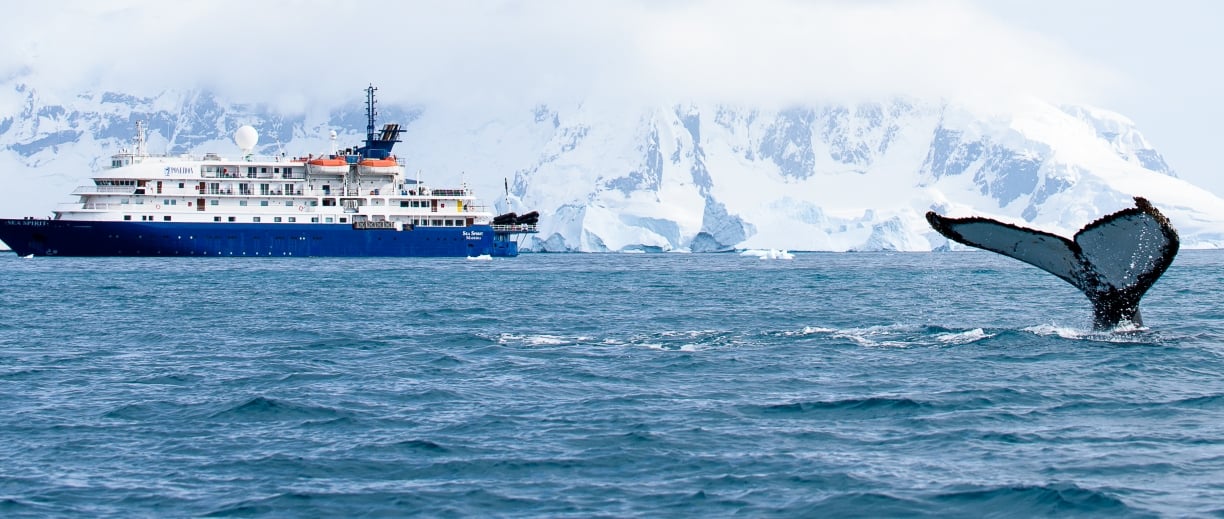
Did you just see a fin pop out from under the ocean surface? When cruising the Antarctic, our expeditioners seek out the prime spots on deck and on the bridge to spot those gentle giants. You never know when and where you might spot them, but they do roam the Southern Ocean and with a bit of luck you’ll see them! Whales are known to migrate throughout the oceans and during the Antarctic summer they return to feed in the krill-rich waters of the Southern Ocean. Read on and find out which types of whales you can expect to see:
Blue whale: As members of the baleen whale family, these fellows are enormous! At up to 199 tons, they are the largest animals on Earth. Their hearts are the size of an average passenger car. Calves are born at 4,000kg (8,000lbs) - imagine popping out that kind of heavy bundle! They are known to be loud and hungry: blue whales can devour about four tons of krill daily and their calls reach up to 188 decibels.
Fin whale: Coming in second in size after blue whales, they are the fastest whales with speeds of up to 45km/h (30mph). They’re also among the most social whales, with six to ten animals within a family group. During migration or feeding, up to 250 whales can be spotted together.
Humpback whale: Usually preferring a rather solitary life, they carry complex tunes during mating season. While many whales communicate through calls and tunes, humpbacks’ mating calls are unique across their species and the song of a mating male can last up to 20 minutes. To produce their iconic sounds, they force air through their nasal cavities.
Minke whale: Minke whales prefer to hunt alone, but do like to look for areas where sea birds feed to get a chance to grab a bite of fish or krill there as well. With a weight of up to 10 tons, they are among the smallest species of baleen whales found in Antarctica.
Right whale: As slow swimmers, they used to be easy prey for whalers during the heydays of whaling and hence deemed the “right whale” (as their name still suggests) for hunting. In addition, they are usually curious and playful around humans and stay closer to the shores than other whales.
Sei whale:
Say what? You actually pronounce their name “say” whale. While shallow divers, they can reach speeds of up to 80km/h (50mph) for short distances, making them one of the fastest aquatic mammals.
Sperm whale: When spotting a sperm whale in Antarctica, you can most likely be sure that it’s a male. They prefer colder water and a solitary lifestyle. Female sperm whales prefer to stay farther up north. Sperm whales are deep divers and can dive down to 2km (1.2 miles).
Petrels – Smelly, but social 
src="/upload/medialibrary/5b1/01S_4835%20(1).jpg" height="409" title="Petrel.jpg" style="font-size: 14px;">
You can spot these social birds in densely packed colonies in Antarctica and the subantarctic islands, predominantly in coastal areas. These colonies usually feature far more females than males and hence some females do not get to breed every season. Breeding females take non-breeding ones quite literally under their wing to help them gain experience in raising offspring for when it will be their turn. These birds also produce a foul-smelling oil in their stomachs, which is used for nutrition during long flights, to feed their young ones and as a defensive spray against predators. Ironically, petrels, with their elongated nostrils, have a very keen sense of smell, which is quite unusual for birds.
Albatross – Long-living lovebirds with a wandering eye .jpg)
With an impressive wingspan up to 3.3m (11feet), they can glide for hours powered by ocean winds without a rest or flap of their wings. Albatrosses can smell food in the water from 20km (12 miles) away! They feed on fish and squid, but also know where to get the “good” stuff. They follow ships in hope of some garbage or friendly sailors sharing their food with them. Did you know that these birds can live and breed well into their 50s? One female was recorded at 70 years, still happily breeding! While for the most part socially monogamous, pairs usually separate after the breeding season only to reunite when it’s time to mate again. It sounds romantic, but in reality, it’s not unheard of for males and females to have some hanky-panky going on while away from their mate. These extra-marital affairs sometimes result in offspring and in Oahu, Hawaii female single-mom albatrosses have been observed pairing up with other females to raise their illegitimate chicks together!
Antarctic Skua – Boisterous bullies with a macabre palate
.jpg)
Living most of their lives at sea, Antarctic Skuas come to snow-free and preferably rocky shores during breeding season. With a preference for fish and krill, they are quite nasty when it comes to securing their meal. They are not only incredibly territorial when it comes to their feeding grounds, but also steal food from other birds, tugging and grabbing their wings and pestering them until they drop their catch! Skuas are also known to prey on penguin colonies to snatch unattended eggs or chicks, kill weak shags and petrels and pick on bird carcasses. Even scraps and garbage from ships are a welcome snack for these birds. While you can spot them during breeding season in Antarctica, skuas migrate as far as Alaska and Greenland during the Antarctic winter.
Blue-eyed shag – The gluttons of the deep .jpg)
Don’t be misled by their name – their eyes aren’t actually blue. Their iris is circled by a blue ring, which gives them their iconic appearance. Each breeding season monogamous couples breed between three and five eggs in their large grassy nesting areas. Blue-eyed shags are very social and have a unique way of feeding in groups! They form large rafts of hundreds of birds luring large schools of fish towards them and dive down continuously to make their catch. Panicking fish then have nowhere to go, other than in one of their hungry beaks.
Key Takeaways
Antarctica is full of life:
It’s the driest and coldest place on Earth and yet around 235 animal species call Antarctica home. Overall, over 1,142 species (including lichens, mosses and marine invertebrates) thrive on and around the White Continent. Great places to spot wildlife include the Antarctic Peninsula (abundant seal species like leopard seals can be found there), South Georgia Island (famous for king penguins, southern fur seals and southern elephant seals) and the Falklands (with its abundance of gentoo penguins and rare seabirds such as southern giant petrels).
Antarctic krill feeds the entire Antarctic region:
The five (out of 86) species found in the Southern Ocean are a vital lifeline for Antarctica’s wildlife. Marine mammals such as blue whales, toothed whales, humpback whales and killer whales (belonging to the dolphin family) feed on this nutritious delicacy. Krill is also an important part of other Antarctic animals’ diets, such as Antarctic seals, emperor penguins and sea birds.
You can only find penguins in the Southern Hemisphere:
If you’re a penguin lover, research where your favorite species prevails! Some types, like emperor penguins, are found on the Antarctic continent, while Magellanic penguins are found on the subantarctic islands and in South America. They are one of the most iconic animals in Antarctica for visitors to see.
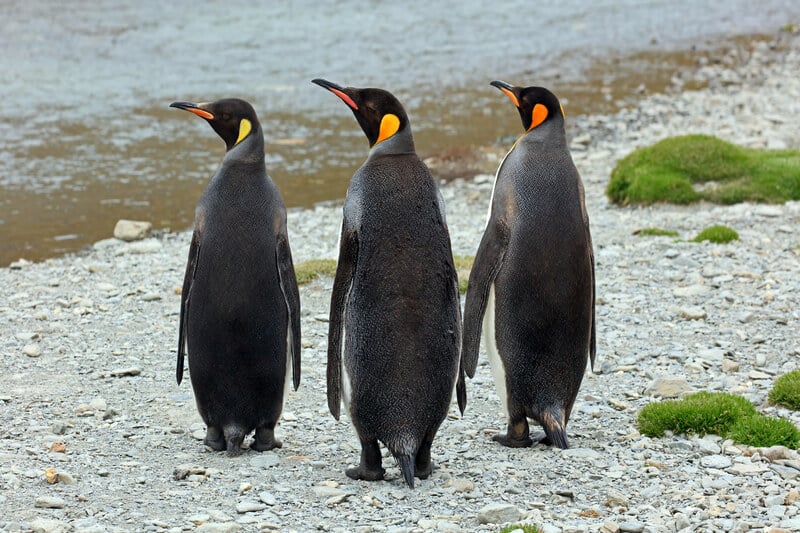
South Georgia is a paradise for Antarctic animal life:
For all wildlife enthusiasts, we strongly recommend booking a cruise that covers not only the Antarctic Peninsula, but also South Georgia. This uninhabited island boasts incredible numbers of penguins (you can observe penguin family life in their large colonies) and huge male elephant seals with their much smaller female partners lazing on pristine beaches. You can also spot blue whales!
Choose a cruise:
Most of the local wildlife can be found in the coastal regions and in the ocean. Cruising aboard a small expedition ship, sailing in Zodiac boats and kayaking will give you the chance to observe these amazing creatures without disturbing them. Professional guides and specialists will tell you everything you always wanted to know about Antarctic wildlife!
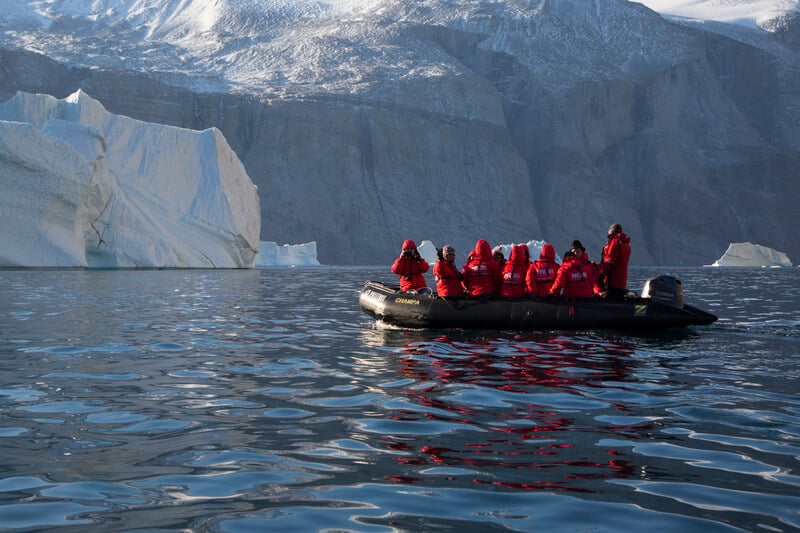
Unique human encounters with animals in Antarctica:
Gentoos are known to have tried courtship with humans, romantically handing them pebbles. They are among the more social animals in Antarctica, whereas Magellanic penguins tend to avoid humans as much as possible. There has even been a case of a leopard seal taking pity on National Geographic photographer Paul Nicklen by bringing him penguins for food (undoubtedly the seal deemed Mr. Nicklen a no-good hunter and felt the need to help him out).
Preservation & protection of animals in Antarctica:
Several organizations are committed to protecting this amazing ecosystem and its Antarctic animals. While the British Antarctic Survey has observed the critically endangered blue whale populations returning to South Georgia, Rockhopper penguins continue to suffer significant population declines. There are constant efforts in place to study and protect the wildlife of this region and to set strict guidelines and rules for tourism. This will not only ensure that generations to come will be able to admire the amazing animals in Antarctica, but preserve this delicate ecosystem.
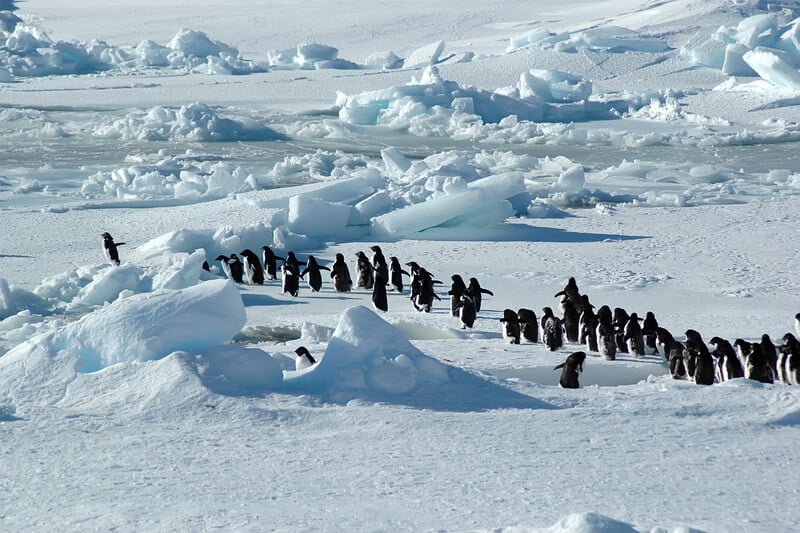
FAQ
How do animals in Antarctica adapt to the cold?
Animals which live in or migrate to Antarctica are perfectly adapted to the harsh climate. Depending on the species, water-repellent feathers, a thick layer of fur or blubber protects them from the cold. Some fish even produce a sort of antifreeze substance in their blood which keeps them thriving.
How many animals live in Antarctica?
Antarctica is home to 235 animal species.
How many species of whales live in Antarctica?
You can spot seven different whale species migrating to and from the Southern Ocean.
How does global warming affect animals in Antarctica?
Rising temperatures, changes in salinity and melting sea ice are likely to endanger the krill population, the main food source of many animals in Antarctica. Since the 1970s, the number of krill has decreased by 80%.
How do animals get water in the dry valleys of Antarctica?
Most wildlife can be found in the oceans and on the shores of Antarctica and the subantarctic islands. Marine birds such as gulls, albatrosses and penguins feature a built-in desalination mechanism, which allows them to drink seawater and excrete excess salt via glands connected to their bills. Most seals get their water from the fish they consume. Their kidneys are specifically adapted to conserve water within their bodies and they recycle water by exhaling air through a countercurrent heat exchange. Warmer exhaled air condenses while passing through cooler nasal passages, thus retaining water. Seals, whales and dolphins actually drink seawater as their kidneys are adapted to such amounts of salt.